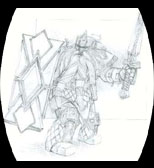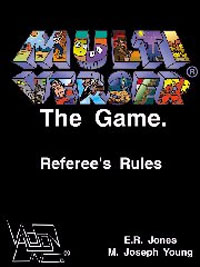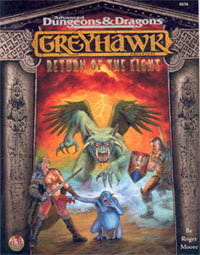My poor inbox (which was already wallowing under an inundation of holiday e-mails I have been unable to keep on top of) has been getting hit hard this morning with people asking me what I think of the freshly announced 5th Edition of D&D.
Short answer: I don’t really think anything about it. We know absolutely nothing about it, after all.
Slightly longer answer: According to ENWorld, the news was leaked to them in “early winter last year” and, at that time, the game had been “under development for some time” (to the point where they had a rough rules draft ready for playtesting by the press).
From this, it’s pretty easy to conclude what was already obvious when Slavicsek left the company and they started cancelling products: The Essentials product line was deemed an immediate failure by WotC . (Just as the early release of the Essentials rulebooks in 2010 told you that 4th Edition, as a whole, had failed.)
LOOKING AHEAD
I’ve said in the past that I currently don’t see a winning business strategy for WotC with a 5th Edition. Unsurprisingly, nothing I’ve heard in the last three hours has changed that opinion.
It should be relatively self-evident that the goal of a 5th Edition at this juncture is to re-unify the D&D customer base. (All the talk of “unity” in the announcement, of course, only confirms this.) But for all the talk about a “public playtest” and “asking D&D fans what they want in a new edition”, I’m not really seeing the mechanism by which 5th Edition solves WotC’s problems.
WotC, ultimately, faces an immutable truth: No reboot edition of an RPG has ever succeeded unless there is clear, deep, and widespread dissatisfaction in the existing customer base. And, as far as I can tell, there is no such dissatisfaction in the 4th Edition customer base. The biggest gripes they seem to have (if any) are the mini-revision of Essentials, the lackluster DDI support, and the lack of printed supplements. None of those complaints suggest a deep dissatisfaction with the system itself (quite the opposite, in fact).
Of course, there is widespread dissatisfaction with 4th Edition among players of previous editions. But that doesn’t actually help WotC.
Basically, the current D&D customer base consists of three broad groups:
(1) 3rd Edition players (either using the original rulebooks or having migrated to Pathfinder). These players, almost by definition, have said, “We’re happy with what we’ve got.” Which isn’t to say that many of them, including myself, aren’t open to new experiences. But the only way WotC can appeal to them en masse is to restore classic 1974-2008 D&D gameplay to 5th Edition.
(2) Unfortunately, restoring the classic gameplay of D&D is almost guaranteed to alienate the existing 4th Edition players.
(3) Finally, you’ve got a relatively small contingent of old school players. These guys are inherently even more conservative than the 3rd Edition players and, frankly, it’s impossible to publish anything new that will appeal to them en masse.
Honestly, I think the most likely outcome is that WotC will produce a game which attempts to return to classic D&D gameplay. But in an effort not to lose their existing 4th Edition players, they’ll try to strike a compromise between the two. The result may or may not be a great game, but commercially it will almost certainly fail: 3E players will reject the 4E elements and stick with the best-supported RPG in history. 4E players will reject a return to “wizard win buttons” and other spherical cows (which will presumably be even less true in 5E).
Things get worse when WotC cancels DDI support for 4th Edition (which seems likely) and creates another group of disenchanted customers who feel alienated and betrayed. Without an OGL to fall back on, a large percentage of this group will exit the game industry entirely.
Basically, my prediction here is that WotC will split their existing 4E fanbase (to one degree or another). They will pick up a relatively insignificant portion of the 3E and OSR fanbases. In short, WotC produces a 5E which performs even worse in the marketplace than 4E.
Things that could mitigate this doomsday prediction:
(1) WotC starts mending fences in really meaningful ways. Specifically, they need to look long and hard at some of the really unpopular decisions they’ve made and work to reverse them: Put previous edition PDFs back on sale. Make Dragon and Dungeon available in print again (even if it’s just POD).
(2) Reach out aggressively for new customers. I don’t know exactly what form this takes, but if WotC can find a way to replenish their customer base with new players then the continued schisming of the RPG marketplace won’t be as significant.
(3) Part of that, however, might be revamping the core products and methodology of your product line. Finding a way to truly abandon the proven failure of the supplement treadmill burnout cycle would also help.
(4) Restore the OGL.
There are also, unfortunately, a lot of things WotC could do that would make things worse.
WHAT WOULD I LIKE?
In an ideal world, I would like the version of D&D that became a missed opportunity in 2008. I talked about it a little bit here:
That’s the missed opportunity here: WotC had the chance to polish and improve Classic D&D; to take the next step with the game. Instead, they side-stepped and gave us New D&D instead.
Meanwhile, Paizo couldn’t make those changes with Pathfinder while simultaneously stepping into the void vacated by WotC.
In short, keep the core gameplay of D&D, fix the handful of problematic abilities at low levels, revamp high level play so that it doesn’t fall apart. Grab the utility of page 42 without the railroading advice and implement a cleaner/quicker system for creating monsters and NPCs.
I would also:
- Look to the OSR and reintroduce game structures that have been slowly stripped out of the game for the past 30 years.
- Embrace the D&D core sets strategy I’ve talked about previously featuring a stripped-down system very similar to what Legends & Labyrinths looks like.
- I would re-introduce the AD&D brand name to produce a Player’s Handbook, a Dungeon Master’s Guide, and a Monster Manual. These would be 100% compatible with the D&D product line. (If you’ve got a D&D module, you can run it in AD&D without conversion. If you create a monster with AD&D, you can run it in D&D. If you’ve got a D&D character, you can start using the AD&D character creation rules any time you level up. And so forth.)
- I’d go back to Dancey’s concept of “evergreen” products and try to make it work by focusing my actual supplement line on opening up new game structures. For example, I wouldn’t produce a book of “rules for ships”. Rules for ships are worthless unless you have a game structure that involves being on ships. What needs to be developed is a game structure for “being pirates” that’s as effective as the game structure for “being dungeoncrawlers”. Pull that off successfully and you’ll have created an entirely new market for adventure products.
- I’m hoping that I can buck the burnout pattern of the supplement treadmill by locking adventure content, rule content, and physical goodie content together into the boxed sets. If that doesn’t pan out, I’d just turn the boxed sets into limited editions and cycle them out of print.
- I would probably do everything in my power to avoid publishing splatbooks like Complete Warrior or Arcane Power. These books are not only the metastatic cancer of the supplement treadmill, but they make it actively more difficult for people to embrace non-“core” classes because the non-core classes never receive the same support. I’d rather have people reach for new experiences rather than glutting and then sating themselves on the supplement treadmill for fighters and wizards.
- Bring back the OGL if the legal department will let me get away with it.
If we got my “perfect edition”, would it make 5th Edition a success? Unfortunately, no. I believe it probably would have been a huge success in 2008 (particularly if released under the OGL) when the D&D trademark would have helped transition existing players to it.
But in 2011, at least half of WotC’s former market no longer has any loyalty to WotC or the D&D trademark. There is no easy mechanism for leveraging those players into a new edition, which means that you’re competing not only with their existing investment (of time, money, and experience) but with the most expansive library of support material ever produced for an RPG.

 My next PC:
My next PC:











